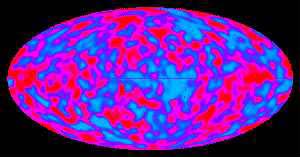The Origin of the Expanding Universe: Big Bang Theory
Big Bang Theory
The Big Bang Theory is the dominant scientific theory about the origin
of the universe. According to the big bang, the universe was created
from a cosmic explosion that hurled matter and in all directions.
George Lemaitre was the first to propose that the universe began with
the explosion of a primeval atom. His proposal came after observing the red
shift in distant nebulas by astronomers to a model of the universe based
on relativity. Years later, Edwin Hubble found experimental evidence to help
justify Lemaitre's theory. The big bang was initially suggested
because it explains why distant galaxies are traveling away from us at great
speeds. The theory also predicts the existence of cosmic background radiation
(the glow left over from the explosion itself). The Big Bang Theory received
its strongest confirmation when this radiation was discovered
by Arno Penzias and Robert Wilson (Kolb, 201-249).
How long ago was the Big Bang?
Common estimates of the age of the universe (and therefore
for the time since the big bang) range from 10 billion to 20 billion years.
Discovery of Background Radiation by Penzias & Wilson
A microwave radiation background was discovered coming
from all parts of the universe by Arno Penzias and Robert Wilson in 1964 (Kolb,
pg.239). This was a strong piece of evidence for the Big Bang theory
of the origin of the universe. When the big bang occurred
a tremendous amount of energy was let loose in the form of radiation, and
when the universe cooled enough for atoms to form there was finally enough
room for the photons of radiation to travel in a strait line.
Why 3 degrees?
Since the big bang the universe has had many billion
years to cool, and so all the energy of the event has cooled and expanded
until it is the approximately 3 Kelvin that we measure it to be.
The temperature of the radiation is remarkably consistent throughout
the sky. The color variation on the figure below signifies temperature
differences of 0.1 degrees kelvin or less. This has lead physicists
to wonder how the universe became so uniform after the big bang, since it
has been expanding the whole time and the distant parts of the universe haven't
had time to interact, since nothing can travel faster than the speed of light.
![[penzias and wilson]](penzias_and_wilson.jpg)
